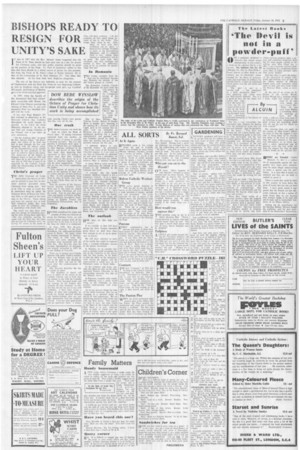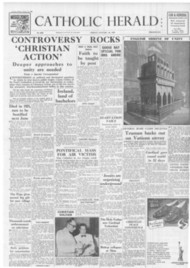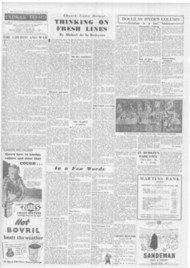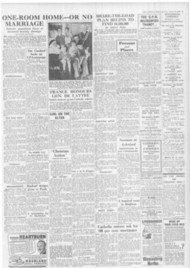Page 2, 18th January 1952
Page 2

Report an error
Noticed an error on this page?If you've noticed an error in this article please click here to report it.
Tags
Share
Related articles
Cotswold Vicar Who Inspired Ecumenism
How It All
The Church Unity Octave Sir, May I Correct An Error
The Late Abbe Couturier
Evening Mass For The Unity Octave
BMWS READY TO1 RESIGN FOR UNITY'S SAKE
IT was in 1907 that the Rev. Spencer Jones suggested that the Feast of St. Peter should be kept each year as a day for prayer for Christian unity, ahd that public sermons should be given on the position of the Pope. Fr, Paul of Graymoor added to this idea that there should be a whole octave of prayer for this purpose, but from the Feast of St. Peter's Chair at Rome (January 18) to that of the Conversion of St. Paul (January 25). This latter idea was adopted. At the time both were Anglican clergymen.
The aim of the Octave was definitely to pray for the reunion ofChristendom with the Holy See. From its very beginning Catholic as well as Anglican clergy and lay-people took part, e.g. Cardinal O'Connell, Archbishop of Boston, gave it his whole-hearted approval.
In 1909, when the Society of the Atonement had been corporately reconciled with Rome, the Church Unity Octave received the blessing of Pope Pius X. and each successive Pope has identified himself with the work.
It was after Pope Benedict XV had extended its observance to the Universal Church that Catholics throughout the world became interested. In the U.S.A. the whole Hierarchy adopted it. In the mission field and among Catholics of the Oriental rites it was taken up with enthusiasm.
" On the Anglican side." to quote the Rev. Spencer Jones. " the movement, like others of its kind, has bad to pass through the fire, and, beginning with the inferior clergy on the circumference, to be content to make its way gradually to the seats of authority and to the centre. 'the observance of the Octave in England began at once in 1909 and was taken up in Nei colonies, yet it was only in 1918 that it canee to be organised by the Catholic 1.eague under the chairmanship of the Rev. Fynes-Clinton."
Christ's prayer
THE Abbe Couturier of Lyons • heard about the Octave in 1932, and he realised at once that its doctrinal position prevented many Christians fromtaking part. And so in 1934. in order to avoid this, he established what he called the Universal Week of Prayer for Christian Unity to take place at the same time as the Octave. Those taking part were left entirely free to hold their respective faiths; they were asked to pray for Christian unity in accordance with God's will.
The result was that there were now two groups of Christians praying for unity during these eight days -the one explicitly praying for union with the Holy See, the other also praying for Christian unity hut leaving the results in the hands of God. praying Christ's own prayer, that they may all be one.
One truth
THE Abbé Couturier sets forth the basis on which the Week of Prayer rests: " If among Christians separated from one another, an identical spirit of prayer is possible, is becomes necessary. But it is only possible if Christians meet again in Christ, in Whom they are implanted by their Baptism, perfected in the sincerity and loyalty of their faith. They must, then, deploring their separation in Him, and hoping to obtain from Him their complete unity. listen to His prayer so as to repeat it, absorbed together in one and the same supplication. ' There will be but one Christ supplicating the Father.'
" This oneaiess of prayer is the result of the oneness of their love for Christ, and for all their brethren in Him. It will undoubtedly bring them to unity of Faith; since there is but one Christ there can be but
One Truth."
Thus the prayers of the January Octave become Christian Unity Week and in this form are indeed spread among Christians all over the world. Year by year they grow wider and deeper in French and Belgian Catholicism, throughout Anglicanism. in English. French and Scandinavian Protestantism, also in Orthodoxy.
The Jacobites
HAVING considered the origin and purpose of these two Octaves of prayer for Christian Unity, we will examine some reunion work of the present day in the East, so as to sec the lines on which it is conducted.
• In June. 1950. Mar Seyerios, Bishop of Tiruvalla. of the SyroMalankara rite. addressed the Unitas group in Rome. He spoke about the reunion movement in Malabar. This began in 1930 when Mar Ivanicts and some thousands of Jacobites were reconciled with the Holy See. Mar Severios, then the Jacobite Metropolitan of Niranam, was himself reconciled in 1937: he is now Bishop of Tinivalla.
There are at present two Catholic dioceses with some 70.000 Catholics. Their two Bishops hope to put an end to the split in the 'Malankara Church in 1953: this will be 300 years after the commencement of the schism.
Mar Severios describes the line of action he takes:
" The Jacobites in theory will have to admit all the claims of the Catholic Church. and in faith they are almost at one with the Catholic Church. Their liturgical hooks and the writings of the Fathers they venerate all hear testimony to this. Yet they do not see eye to eye with Catholics. I have been trying a policy of love and sympathy towards my former spiritual children and brother-bishops who are outside communion with the Catholic Church. 1 La n see their good points and do apprejate them. I svnipa thise with their weakness. I do not condemn all their good things because of one or two faults. 'This brings them closer to me. Only when we have won their confidence can we speak to them of their failings. To speak to them of the hair-splitting differences. and to condemn them in tow, calling them heretics or schismatics. will do no good. We must study their viewpoint and their teachings and explain to them the differences, using as far as possible the terminology they use."
In. Rumania
TWO further examples from the East can be mentioned because they illustrate the attitude of the old Uniate groups to reunion.
The Rumanian Catholic Church of the Byzantine rite dates from the 17th century. In 1948, through t he Communist seizing of the country. this Church was
legally, wiped
out. All its six Bishops were
arrested. The Church has. as a matter of fact, gone underground. One of these Bishops, Mgr. Valerius Frentiu. Bishop of Oradea Mare, in happier days, speaking at the opening of a diocesan synod at Lugoi. gave as his opinion that reunion with the Orthodox in Rumania was not a doctrinal and ideological problem but a purely administrative and personal one. and Catholics should be ready to make any sacrifice and give up all personal interests for this end. I solemnly declare to you, venerable fathers." he concluded, " that if the union of the Rumanian Churches requires it, I am ready at any time to relinquish my episcopal see and retire into a monastery. or I am ready to undertake any administrative office or pastoral charge."
A young Melkite priest wrote last year concerning the attitude of the Uniatess to the Orthodox M the Lebanon and Syria:
"I consider that the Greek Catholic (Melkite) Church is but a temporary Church. It is a necessary evil to maintain a double Hierarchy till the relations between Rome and Orthodoxy, with God's grace and the goodwill of all, becomes again normal, as it was dur ing the first centuries. 1 have serious grounds to believe that if a union was settled. all the GreekCatholic Bishops would resign and join the ranks of the renewed Orthodox Church. The mission of the Greek-Catholic should he to live more deeply and ardently in the genuine Orthodox tradition and to serve as a humble link between Rome and Orthodoxy."
The outlook
HOW does all this help our prayer?
If we consider in their full local setting the three Eastern examples given' above we shall have more than enough to stir us up to persevere in prayer.
We will draw attention to some of the results that might be expected from a Catholic-Orthodox reunion in the places mentioned.
In Malabar. let us consider how such a reunion would strengthen the rest of the Catholics in the district and, for that matter, in all India. as also the effect on the missionary work among the pagans, and the repercussions it would have on the Protestant union in South India.
In the Lebanon and Syria, consider the effect not only on the other separated Eastern Churches in the surrounding countries, but also on the Moslem Arabs.
In Rumania. consider what vitalite and stiffening such a union would bring to the Orthodox in their present confrontation with Communism.
As to our prayers along the lines of the Abbe Couturier, here we are engaging in a spiritual union of prayer of vital importance. We are identifying ourselves with Christ and with the Holy Spirit. This cannot hut lead to unite, for since Christ is the Head of the Church and the Holy Spirit is its Life, wherever there is faith in Christ and the Spirit of Christ, there is the spirit of units and the means of reunion.
blog comments powered by Disqus






